Introduction
The largest amount of biochemical and genetic diversity on Earth exists within the prokaryotic domains Archaea and Bacteria. Members of these domains are found in every conceivable (and sometimes inconceivable) environmental niche based on their ability to utilize diverse energy sources, electron donors and acceptors (8). Because higher organisms on Earth evolved in the presence of prokaryotes, they are intimately associated with every organism. Prokaryotes are responsible also for most of the major steps of biogeochemical cycles without which plant, animal and human life would be impossible.
A subclass of prokaryotes of direct interest to plant pathologists includes those bacteria that interact intimately with plant hosts and directly affect overall plant health and survival. Some prokaryotes serve to improve plant health while others negatively impact plant health, ranging from slightly deleterious effects to partial or complete death of the plant. The development of the technology to sequence large stretches of DNA (genomics) and to analyze this DNA (bioinformatics) is beginning to have enormous impacts not only on the way scientists carry out research but also in the way we think about the overall biology of plant-microbe interactions.
History
It can be argued that the field of genomics actually began several years ago in virology, where the ability to determine the DNA (or RNA) sequence of a virus allowed comparisons of genomes, enzyme activities, and many other aspects previously difficult or impossible to perform (7). The net effect of the development of viral genomics was the revolution of plant virology and the resultant explosion in our understanding of plant-viral interactions.
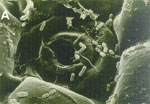
Fig.1. Click image for an enlargement and more information.
|
|
In an analogous manner, the emergence of microbial genomics will enable us to answer classical questions about plant-associated microbes that once seemed, at least to some of us, as unobtainable as intergalactic space travel. In the pre-genomics era, we probed the microbial universe one factor at a time, adding incrementally to our knowledge of one or a few bacteria. As we enter the age of high throughput sequencing, or what is referred to as "the age of genomics," scientists can begin to use a holistic approach for answering questions of consequence to plant health. Some of the many exciting questions are:
|
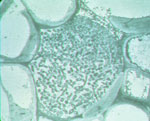
Fig.1. Click image for an enlargement and more information.
|
|
- What is the minimal set of genes required for survival on or in a plant?
- What is the arrangement of pathogenicity and virulence genes in plant pathogenic bacteria?
- Are genetic determinants of host range or host preference clustered in the genome?
- Are there distinctive features that will predict a bacterium's ability to survive on or in different plant parts? (Figs. 1 and 2)
As recently as 1995 The Institute for Genomic Research (now part of the J. Craig Venter Institute) published the first complete sequence of a bacterial genome. Since then the number of completed bacterial genomes has risen to 24. Several others are expected to be completed within the next 2 years (See Genomes OnLine Database). Most of the genome sequencing efforts so far have targeted medically or industrially important microbes and relatively few target plant-associated bacteria. Fortunately, genome sequencing efforts in Brazil, France and the United States increasingly focus on plant pathogenic bacteria. In their very recent article, a team of Brazilian scientists from São Paulo present the first complete genome sequence of a phytopathogen. Simpson et al., (10) sequenced the entire genome of a strain of Xylella fastidiosa, and will soon finish sequencing another plant pathogen, Xanthomonas axonopodis pv. citri. In 2000, the United States Department of Agriculture (USDA) launched the first US public initiative for complete genome sequencing of agriculturally related microbes, including plant-associated bacteria (IFAFS). Together with private ventures in the US, France and elsewhere, the amount of genomic information on plant-associated bacteria is increasing exponentially.
APS Symposium on "Genomics of Plant-Associated Bacteria"
The age of microbial genomics and its implications for plant health will be highlighted at the upcoming 2000 Annual Meeting of the American Phytopathological Society (August 12-16, 2000, New Orleans) in a symposium entitled "Genomics of Plant-Associated Bacteria". The APS Bacteriology Committee is sponsoring the symposium. Co-organizers for the symposium are Leland S. Pierson III, University of Arizona, and Carol A. Ishimaru, Colorado State University. An international group of speakers will present the current status and future goals of several essential microbial genome sequencing projects. The symposium will be held Tuesday, August 15, 2000 from 1:00 to 5:00 PM. The symposium is supported by funds provided by the APS Council, the College of Agriculture and Life Science at the University of Arizona, and the Colorado Agricultural Research Station and College of Agricultural Sciences at Colorado State University. Funds for the Symposium are provided also through a work agreement between the Animal and Plant Health Inspection Service (APHIS)/USDA and the APS Bacteriology Committee, which resulted in a summary of plant pathogenic bacteria prevalent in the U.S.
Generation of sequence data
The genomes of plant-associated bacteria contain DNA, which is made up of the four nucleic acid bases, adenine (A), guanine (G), thymine (T) and cytosine (C). It is the specific number and order of these bases that uniquely identifies an organism. Bacterial genomes consist of large DNA molecules arranged in one or more circular or linear chromosomes. In addition to chromosomes, bacterial genomes often contain extra chromosomal DNA molecules, called plasmids, which may vary in length from a few kilobases (kb) to over 400 kb. Estimated genome sizes of plant pathogenic bacteria vary among species. Some of the smaller genomes are estimated to be in the range of 2.5 million (mega) base pairs (Mbp) and the larger ones are probably greater than 5 Mbp.
The goal of genome sequencing is the production of a map that identifies the linear arrangement of all bases in an organism's DNA. Obtaining such a map is not a trivial undertaking; however, technical advances in sequencing and data processing continue to reduce the time and expenses involved. The complete sequencing of a 2.5-Mbp genome presently can take less than six months at a cost of less than $500,000.
Obtaining the complete sequence of an organism usually involves multiple sequencing strategies. A common approach is to use a combination of shotgun-sequencing, in which small fragments of the DNA are cloned and sequenced, followed by a gap-closure phase (10). In the latter, larger DNA fragments contained in cosmid or BAC libraries are sequenced. When finished, the complete sequence gives the exact size and structure of the genome, including the number and form of chromosomes and plasmids.
Sequence annotation (Bioinformatics)
To make biological sense out of all the As, Ts, Gs, and Cs, sequence data must be "mined" or analyzed by software specifically developed to identify possible open reading frames (ORFs). While ORFs are associated with sequences that are transcribed and translated into proteins, other sequences give information about gene expression. The term bioinformatics describes the mining of biological sequence information to predict gene function, protein and RNA structure, gene regulation, genome organization and phylogenetic history of genes and gene families. During this process (Fig. 3), a test sequence is compared to all the sequence information deposited in worldwide gene banks. Database searches provide a probability score that one sequence is similar to another. If highly significant, these similarities may infer homology (relatedness through evolution) or function (9). The result of all this data mining is an annotated map of the genome.
|
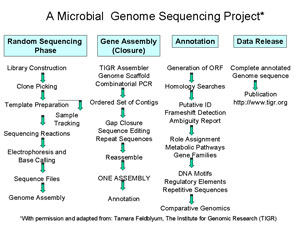
Fig. 3. Click image for larger view.
|
Comparative genomics: an emerging field
Recent software developments enable analysis of the extremely large data sets generated by complete genome sequencing and provide for comparisons at the whole genome level. As an example, the program MUMmer (Maximal Unique Match) aligns segments of closely related DNA sequence several million base pairs in length (3). This level of data mining or "comparative genomics" has direct and exciting implications for plant pathology. As the number of complete genome sequences increases, comparisons across genera, species, subspecies, pathovars, and strains will become possible.
What can we learn from a genomics approach?
Through genomics, we can begin to address questions about the evolution of plant-associated bacteria. By comparing the arrangement of DNA along entire genomes, we can begin to propose models of how genetic information passed between organisms. Envision the magnitude of this new perspective as the difference between looking at the earth from your back porch and looking at it from a space shuttle. All inversions, rearrangements, and insertions in an organism's genome would be viewable, giving rise to all sorts of questions: What does the arrangement of genes in a pathogen tell us about evolution of host specificity or pathogenicity? Which sequences indicate gene transfer between related or unrelated organisms? The range of exciting research questions being limited only by the imagination.
The complete genome sequence gives the exact proportion and distribution of each of the four bases in the genome. The relative amount of each base, reported as the G+C content, is characteristic of a genus. Based on prior measurements, the genera of certain plant pathogenic bacteria, such as Erwinia, are predicted to have moderate G+C contents, while others, such as Clavibacter and Pseudomonas, are predicted to have much larger G+C contents (upwards of 70%). Localized variations in the G+C content along the genome have significant implications for understanding the potential routes of genetic exchange between organisms. For example, by using genetic tools such as transposon mutagenesis and gene complementation, plant bacteriologists have located and sequenced large segments of DNA associated with pathogenicity. The G+C contents of some of these pathogenicity-related regions are distinct from the overall G+C content of the organism. From this and other information, scientists postulate that the presence of "pathogenicity islands" can indicate how some bacteria may have evolved to become pathogens (2,5,6) (Fig. 4).
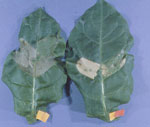 |
|
Fig. 4. Hypersensitive response (HR) in tobacco caused by cells of Erwinia amylovora (right) and Clavibacter michiganensis (left). Genes required for HR production and pathogenicity are clustered in the genomes of Gram-negative bacteria, such as E. amylovora (Click image for larger view). |
With a major emphasis on large-scale sequencing of plant-associated bacteria will come knowledge of the functional relationships between bacteria, especially those with different pathogenic life styles. Perhaps we will find evidence that genomes of bacteria from similar habitats contain similar sets of genes required for survival in that habitat. Perhaps we'll identify regions that are distinctive of life as an epiphytic or life as an endophyte.
Surely, the era of genomics will usher in significant advances in our understanding of plant-microbe interactions. A few of the many possible breakthroughs will be in:
- Identification of new surface proteins that play critical roles in plant-microbe interactions;
- New insights into unique biochemical pathways critical for plant-microbe interactions;
- Identification of requirements for culturing fastidious microorganisms such as phytoplasmas;
- New targets for specific and sensitive detection of plant-associated bacteria.
Changing science and plant pathology forever
The World Wide Web affords immediate access to all the available information contained in an organism's DNA. This access results in near real-time feedback and analysis by the entire scientific community. As Dr. Stanley Falkow eloquently said recently, "[Genomics] reminds me of the 'good old days' of bacterial conjugation when each day's experiments revealed some new facet of genes and biology.... There was just too much to discover to worry about competition" (4). Genomics challenges our academic institutions to provide new graduate education experiences that can advance the use of these strategies and develop new partnerships between disciplines. Already disciplinary lines are becoming blurred and discipline insularity is becoming less prevalent.
What's next?
Once the complete genome sequence of an organism is known and annotated, the next challenge is identifying gene functions of all possible ORFs. Plant pathologists will provide the human intelligence needed to analyze and rank the importance of the ORFs for their possible biological significance. Bioinformatics approaches will identify functions of a portion, but not all, of the ORFs in a genome, and some of the assigned functions may actually be incorrect. In Escherichia coli, the common intestinal bacterium now studied intensively for over forty years, the functions of one-third of its 4,288 ORFs (ca. 1,415) are still unknown (11). Thus, gene disruption and replacement experiments will continue to play a critical role in functional analyses of predicted ORFs. Still, the shear volume of sequence data generated by genome projects demands improvements be made in technologies for functional analysis. One such technology is DNA microarrays, which have quickly become the method of choice for examining gene expression on a genomic scale (for related article, see Nature Genetics, Supplement, volume 12, 1999).
The ultimate goal
With the development of microbial genomics comes a responsibility to plant pathologists of making the most of these powerful resources. We must begin applying this information for reducing threats and losses from plant pathogenic bacteria and for improving the viable use of beneficial bacteria. There are very few means of controlling plant pathogenic bacteria. The limited number of chemicals and sources of disease resistance means the best strategy is still prevention through exclusion. Plant virologists have already utilized their knowledge of complete plant viral genomes to develop transgenic virus-resistant plants. Will we be able to do the same with bacterial genomics? Perhaps other methods of disease control will develop in a manner analogous to pharmaceutical approaches for veterinary and clinical medicine. Knowing the complete genome sequences of many plant-associated bacteria may allow us to identify the Achilles' heel of a plant pathogenic bacterium or alternatively to convert a potential silver bullet to a golden one.
An international cast of speakers
The APS Symposium on "Genomics of Plant-associated Bacteria" will feature an international assembly of experts in microbial genomics working on a wide-range of plant-associated bacteria. They include:
Noel Keen (Dept. of Plant Pathology, University of California, Riverside, Riverside, California, 92521).
Dr. Keen's research has focused on the molecular biology of plant-pathogen interactions, with emphasis on high and low molecular weight signal molecules. Plant disease resistance mechanisms are governed by single Mendelian genes called disease resistance genes. They are involved in the recognition of pathogen produced metabolites, called elicitors, to activate plant defense mechanisms. Dr. Keen's laboratory is involved in the isolation and characterization of several of these elicitors, which are somewhat analogous to antigens in vertebrates. Dr. Keen is involved currently in the sequencing of the genome of the plant pathogen Erwinia chrysanthemi. E. chrysanthemi is a necrotrophic plant pathogen that produces pectolytic enzymes that cause severe soft-rot disease in a wide number of plant hosts.
Andrew Simpson (Ludwig Institute for Cancer Research, São Paulo Branch, Sao Paulo, Brazil).
Dr. Simpson is involved in determining the sequence of the genome of Xyella fastidiosa, best known as the causative agent of Pierce's disease on grapevines. However, X. fastidiosa is also responsible for the devastating disease Citrus Variegated Chlorosis (CVC). CVC was first identified in São Paulo and Minas Gerais States in 1987 and was shown to affect all commercial sweet orange varieties. The disease spread rapidly by the use of infected budwood for graft propagation and by sharpshooter insect vectors. It is now widely distributed in all citrus growing regions of Brazil. CVC is now a major concern to the Brazilian citrus industry and is considered to be potentially an industry devastating citrus disease. CVC has been found only in Brazil and Argentina. Disease symptoms include mottled and interveinal chlorosis similar to that seen associated with zinc deficiency, reduced leaf size, and fruit that are small, early maturing, and have a very hard rind which can damage juicing machines. Young leaves do not show symptoms. As the leaves mature, small light brown gummy lesions appear on the under side of the leaves which correspond to the yellow chlorotic areas on the leaf upper side. The lesions on the under side of the leaves may become dark brown or even necrotic. For more imformation, see the X. fastidiosa Web site.
Fernando de Castro Reinach (Instituto de Química, Departamento de Bioquímica (USP), Av. Prof. Lineu Prestes, 748 Cidade Universitária 05508-900 São Paulo, SP).

Fig. 5. Symptoms of citrus canker on lime. Photo courtesy of D. W. Gabriel (click image for larger view).
|
|
In Brazil and around the world, Xanthomonas axonopodis pv. citri causes citrus canker in citrus plants with an annual economic impact estimated at tens of millions (Fig. 5). Many other related Xanthomonas species attack other economically important crops such as rice, cotton, beans, and grapes. Knowledge of the complete sequence of the X. axonopodis pv. citri genome will therefore be of enormous potential value to both the Brazilian internal economy and numerous agricultural sectors in a large number of countries worldwide. The genome database generated by this project will be an important resource in efforts to understand Xanthomonas biology in general and the variety of Xanthomonas-host interactions of economic consequence. Furthermore, this genome sequence will be of tremendous use in basic research into the molecular basis of plant-pathogen interactions since the closely related X. campestris pv. campestris is currently being used as a model pathogen in studies with Arabidopsis thaliana. Arabidopsis, whose genome will be completed shortly, is the model organism for studies of plant genetics. Finally, X. axonopodis is a close relative of Xylella fastidiosa, but has a genome of approximately twice the size. (It is estimated that the genome of X. axonopodis pv. citri has approximately 5 Mbp.) The availability of the two genomes will allow us to compare the genetic makeup of these two species and gain insight into the important similarities and differences which determine their unique metabolisms, life cycles and interactions with their common host. For more information see the Xanthomonas citri Genome Project Website.
Christian Boucher (Institut National de la Recherche Agronomique, Centre de Recherche de Toulouse, Biologie Moléculaire des Relations Plantes-Microorganismes, CHEMIN DE BORDE-ROUGE B.P.27, 31326 Auzeville - Castanet-Tolosan, France).
Ralstonia solanacearum is a Gram negative beta-proteobacterium. This plant pathogen has an unusually wide host range since it causes "bacterial wilt" disease in over 200 plant species belonging to more than 40 botanical families. Strain GMI1000 causes disease on various solanaceous crops, including potato, tomato and eggplant, and on the model plant Arabidopsis thaliana; it also induces a hypersensitive response after inoculation on tobacco. Professor Boucher is a leading authority on the molecular biology of R. solancearum. In collaboration with Genoscope, Boucher and colleagues are obtaining the complete genome sequence of GMI1000 (Plant-Microorganism Interactions).
Eugene Nester (Dept. Microbiology, University of Washington, Seattle, WA 98195-7242).
Dr. Nester's laboratory has been a leader in the molecular analysis of plant-bacterial interactions using the Agrobacterium tumefaciens crown gall-plant tumor system as a model. The soil microorganism, A. tumefaciens, transfers a small piece (T-DNA) of a tumor-inducing (Ti) plasmid out of the bacterium and into plant cells, where it becomes integrated into the plant chromosome and confers new properties on the tissue (Figs. 6A-6D). Agrobacterium is currently being used worldwide to genetically engineer plants. Dr. Nester's laboratory is attempting to understand the mechanisms by which Agrobacterium interacts with plant cells at various levels. Studies in his laboratory have shown that one of the first stages in the bacterial-plant interaction involves the activation of bacterial genes by signals from the wounded plant. These virulence genes, called vir genes, are essential for the processing and transfer of the T-DNA across the bacterial cell wall and into the nucleus of the plant cell. A major focus of his laboratory is to elucidate how Agrobacterium recognizes and processes these plant signals to activate the vir genes. Other studies involve a genetic-biochemical analysis of the vir genes to determine their function in the transfer of T-DNA into plant cells. Dr. Nester's laboratory is responsible for annotation of the Agrobacterium DNA sequence and pursuing the relationship between the sequence and the biology of the organism.
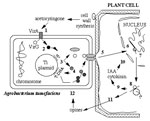
A |
|
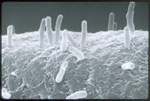
B |
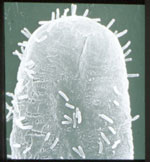
C |
|

D |
|
Fig. 6. Crown gall disease caused by Agrobacterium tumefaciens.
Model of infection (A) showing bacterial attachment to plant cell (B and C) and formation of galls following transfer of T-DNA into plant (D) (Click on images for larger views).
|
Carol A. Ishimaru (Dept. of Bioagricultural Sciences and Pest Management, Colorado State University, Fort Collins, CO. 80523-1177).
The Gram-positive bacterium Clavibacter michiganensis subsp. sepedonicus (Cms) is the causal agent of ring rot of potato, and it is a significant concern to the national and international potato industries. Almost nothing, however, is known about the specific gene(s) in the bacterium that enable it to cause disease (Figs. 7-9). This is in large part due to the lack of standard tools for genetic analysis, such as transposon mutagenesis, for studying Cms or any of the other plant pathogenic coryneform bacteria. Dr. Ishimaru and her colleagues Drs. Dennis L. Knudson and Susan E.Brown, Department of Bioagricultural Sciences and Pest Management, Colorado State University, have initiated a genome analysis of C. michiganensis subsp. sepedonicus as a means of identifying sequences that may be associated with virulence or pathogenicity in Clavibacter. Their strategy to accomplish this objective capitalizes on the gene similarities seen among other more well-characterized animal and plant pathogens. By constructing a sequence-anchored physical map they are providing an immediate picture of where specific genes are located and arranged in the Cms genome. Dr. Ishimaru specializes in the plant-microbe interactions that occur between C. michiganensis subsp. sepedonicus and potato. Drs. Brown and Knudson bring extensive experience in genomics and bioinformatics of mosquitoes and plants to the collaboration (see the Mosquito Genomics Server).
|
Fig. 7-9. Coryneform (club-shaped) cells of Clavibacter (left). Leaf (middle) and tuber (right) symptoms of bacterial ring rot (Click on images for larger views). |
Delphine Capela (for Jacques Batut) MELILO, a European consortium which includes the Laboratoire de Biologie Moléculaire des Relations Plantes Microorganismes (LBMRPM). Centre National de la Recherche Scientifigue (CNRS)-Institut National de la Recherche Agronomique (INRA) BP 27, 31326 Castanet-Tolosan Cedex, France).
Sinorhizobium meliloti (formerly Rhizobium meliloti) forms nodules on the roots of alfalfa as part of a symbiotic relationship with the plant (Figs. 10 and 11). S. meliloti has been a model bacterium for studies on the developmental mechanisms involved in nodule formation. A European consortium led by Prof. F. Galibert and sponsored by the European Union took charge of sequencing the chromosome of S. meliloti strain 1021. Prof. S. R. Long at Stanford University (USA) is responsible for the pSymA project. Sequence of pSymB will be a joint endeavor of Prof. A. Puhler at the University of Bielelfeld (Germany) and Prof. T. Finan and Prof. B. Golding both at Mac Master University (Hamilton, Canada).
The genome of S. meliloti strain 1021 consists of three replicons:
- one chromosome of ca 3.7 Mbp that carries 3 rDNA copies, and
- two large plasmids of ca. 1.4 and 1.7 Mbp that are commonly described as pSymA and pSymB, respectively, because they carry genes essential for symbiosis.
|
Figs. 10 and 11. Genome organization in S. meliloti (left, click on image for larger view) and nodules caused by S. meliloti on alfalfa roots (right). |
Nicole Perna (for Frederick Blattner) (Laboratory of Genetics, University of Wisconsin-Madison, 445 Henry Mall, Madison, WI 53706).
|
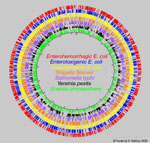
Fig. 12. Comparison of pathogenic enterobacteria to K-12 by genomic sampling (click on image for larger view and more information). |
|
Dr. Blattner's group recently completed the E. coli K-12 genome sequence, and continues to work on the analysis of that organism (Fig. 12). Special interests include the analysis of gene organization, expression, regulation, and functional characterization. The E. coli sequence serves as a baseline for comparative studies of the genomes of pathogenic enterobacteria, and microbial genome organization in general. Currently the laboratory is working on the Bacterial Pathogen Genome Initiative, genome sequencing and comparative genomics. The "Complete Dissection of the Escherichia coli Genome," including global gene expression studies, and the "Natural Variation in O157:H7" are two other projects that the laboratory is currently working on. The laboratory's expertise will allow an overview of genomic analysis in the 21stcentury. In collaboration with Blattner and several plant pathologists, Dr. Perna is investigating the comparative genomics of animal and plant pathogens in the Enterobacteriaceae. For more information, see The UW-Madison E. Coli Genome Project.
References
1. Alfano, J. R., A. O. Charkowski, W. -L. Deng, J. L. Badel, T. Petnicki-Ocwieja, K. van Dijk, and A. Collmer. 2000. The Pseudomonas syringae Hrp pathogenicity island has a tripartite mosaic structure composed of a cluster of type III secretion genes bounded by exchangeable effector and conserved effector loci that contribute to parasitic fitness and pathogenicity in plants. Proc. Natl. Acad. Sci. USA. 97:4856-4861.
2. Blattner, F. R., Plunkett III, G., Bloch, C. A., Perna, N. T., Burland, V., Riley, M., Collado-Vides, J., Glasner, J. D., Rode, C. K., Mayhew, G. F., Gregor, J., Davis, N. W., Kirkpatrick, H. A., Goeden, M. A., Rose, D. J., Mau, B., and Shao, Y. 1997. The complete genome sequence of Escherichia coli K-12. Science 277:1453-1474.
3. Delcher, A. L., Kasif, S., Fleischmann, R.D., Peterson, J., White, O., Salzberg, S. L. 1999. Alignment of whole genomes. Nucl. Acids Res. 1;27(11):2369-76.
4. Falkow, S. 2000. The good old days are now. Trends Microbiol. 8:198-199.
5. Galan, J. E. and Collmer, A. 1999. Type III secretion machines: bacterial devises for protein delivery into host cells. Science 284:1322-1328.
6. Hacker, J., G. Blum Oehler, I. Muehldorfer, and H. Tschaepe. 1997. Pathogenicity islands of virulent bacteria: Structure, function and impact on microbial evolution. Mol. Microbiol. 23:1089-1097.
7. Harrison, B. D. and Wilson, T. M. 1999. Milestones in the research on tobacco mosaic virus. Philos. Trans. R. Soc. Lond. B Biol. Sci. 29;354(1383):521-529.
8. Hunter-Cevera, J. C. 1998. The value of microbial diversity. Curr. Opin. Microbiol. 1:278-285.
9. Nicholas, H. B. Jr., Deerfield, II, D. W. and A. J. Ropelewski. 2000. Overview: Strategies for searching sequence databases. BioTechniques 28:1174-1191.
10. Simpson, A. J. G., F. C. Reinach, P. Arruda, F. A. Abreu, M. Acencio, R. Alvarenga, L. M. C. Alves, J. E. Araya, G. S. Baia, C. S. Baptista, M. H. Barros, E. D. Bonaccorsi, S. Bordin, J. M. Bové, M. R. S. Briones, M. R. P. Bueno, A. A. Camargo, L. E. A. Camargo, D. M. Carraro, H. Carrer, N. B. Colauto, C. Colombo, F. F. Costa, M. C. R. Costa, C. M. Costa-Neto, L. L. Coutinho, M. Cristofani, E. Dias-Neto, C. Docena, H. El-Dorry, A. P. Facincani, A. J .S. Ferreira, V. C. A. Ferreira, J. A. Ferro, J. S. Fraga, S. C. França, M. C. Franco, M. Frohme, L. R. Furlan, M. Garnier, G. H. Goldman, M. H. S. Goldman, S. L. Gomes, A. Gruber, P. L. Ho, J. D. Hoheisel, M. L. Junqueira, E. L. Kemper, J. P. Kitajima, J. E. Krieger, E. E. Kuramae, F. Laigret, M. R. Lambais, L. C. C. Leite, E. G. M. Lemos, M. V. F. Lemos, S. A. Lopes, C. R. Lopes, J. A. Machado, M. A. Machado, A. M. B. N. Madeira, H. M. F. Madeira, C. L. Marino, M. V. Marques, E. A. L. Martins, E. M. F. Martins, A. Y. Matsukuma, C. F. M. Menck, E. C. Miracca, C. Y. Miyaki, C. B. Monteiro-Vitorello, D. H. Moon, M. A. Nagai, A. L. T. O. Nascimento, L. E. S. Netto, A. Nhani Jr. , F. G. Nobrega, L. R. Nunes, M. A. Oliveira, M. C. de Oliveira, R. C. de Oliveira, D. A. Palmieri, A. Paris, B. R. Peixoto, G. A. G. Pereira, H. A. Pereira Jr. , J. B. Pesquero, R. B. Quaggio, P. G. Roberto, V. Rodrigues, A. J. de M. Rosa, V. E. de Rosa Jr. , R. G. de S·, R. V. Santelli, H. E. Sawasaki, A. C. R. da Silva, A. M. da Silva, F. R. da Silva, W. A. Silva Jr. , J. F. da Silveira, M. L. Z. Silvestri, W. J. Siqueira, A. A. de Souza, A. P. de Souza, M. F. Terenzi, D. Truffi, S. M. Tsai, M. H. Tsuhako, H. Vallada, M. A. Van Sluys, S. Verjovski-Almeida, A. L. Vettore, M. A. Zago, M. Zatz, J. Meidanis and J. C. Setubal. 2000. The genome sequence of the plant pathogen Xylella fastidiosa. Nature 406:151-157.
11. Tang, CM, Hood, DW, Moxon, ER. 1998. Microbial genome sequencing and pathogenesis. Curr. Opin. Microbiol. 1:12-16.
